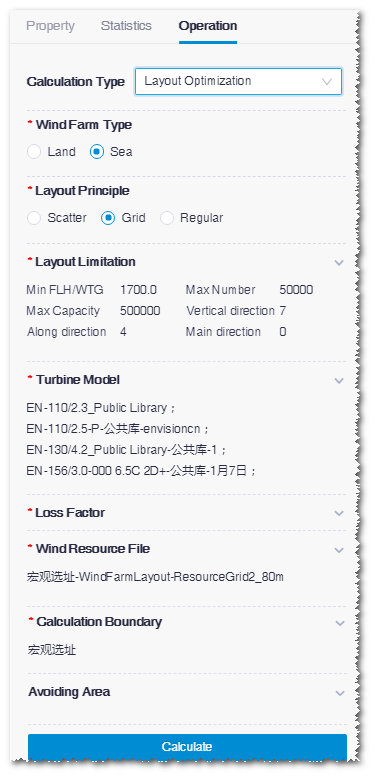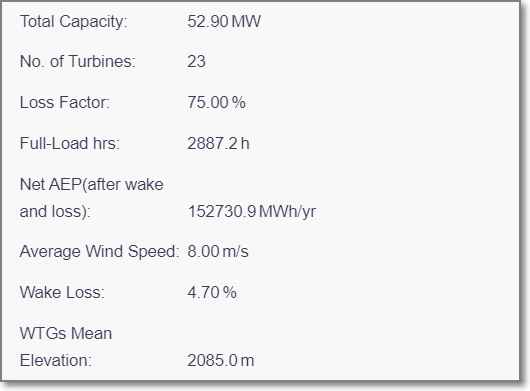Wind Farm Layout Optimization¶
This function is aiming at offering refined turbine layout regulations and optimizing existing wind farm layout for wind farms which have completed macrositing, turbine model configuration, and AEP calculation.
Optimizing Layout¶
The options for the layout optimization parameters might be different according to the wind farm type, layout principle, and target you select. Refer to the following content for details.
Click the WTG group object in the project pane.
Click the expand icon 《 to open the operation pane.
Select Layout Optimization from the Calculation Type drop-down menu.
Figure: Layout Optimization Pane

Click the expand icon
 in the Wind Farm Type area and select Onshore or Offshore. If you select Offshore, no Map option is available.
in the Wind Farm Type area and select Onshore or Offshore. If you select Offshore, no Map option is available.Click the expand icon
 in the Layout Principle area and select Scatter, Grid, or Regular.
in the Layout Principle area and select Scatter, Grid, or Regular.Scatter: This option is applicable for hilly areas or flat areas with limitations. The turbine layout scheme is customized according to your optimization target.
Grid: This option is applicable in wind farm with average-level resource. The turbine layout scheme is customized according to the direction and space you defined.
Regular: This option is applicable in wind farm with average-level resource. The turbine layout scheme with regular layout and optimal power production is provided for solutions.
After the wind farm type is selected, the corresponding options in the Layout Limitation area are displayed.
Click the expand icon
 in the Layout Limitation area and input the following parameters:
in the Layout Limitation area and input the following parameters:Layout Optimization Parameters¶ Name Description Applicable Layout Target Type Three options are available: AEP, IRR, and NPV. Scatter and regular Min FLH/WTG Minimum power production hours of a turbine Scatter, grid, and regular Max Capacity Maximum capacity of wind farm Scatter, grid, and regular Max Number Maximum No. of turbines recommended for a wind farm Scatter, grid, and regular Max wake loss/WTG Maximum wake loss of a turbine Scatter, grid, and regular Max wake loss/WF Maximum wake loss in wind farm Regular Min space Minimum space between turbines Scatter and regular Vertical direction Space between turbines vertical to main wind direction Grid Along direction Space between turbines along main wind direction Grid Array direction Main wind direction angle Grid and regular Direction buffer Set up direction buffer while you set the main wind direction manually. Regular Click the expand icon
 in the Wake Effect area and select wake model and wake decay factor.
in the Wake Effect area and select wake model and wake decay factor.Note
This module is displayed only when you select Regular.
You can select Park Model or Advanced Park Model.
Click the expand icon
 in the Turbine Type area and select the turbine models to be optimized.
in the Turbine Type area and select the turbine models to be optimized.All turbine model series which contain common turbine models are listed, and you can select more than one.
Note
You need to configure in advance the following parameters in the Operation pane of the turbine series: name, rated power, rotor diameter, vave, and turbine price. For details of the configuration, refer to the section Configuring Turbine Model Series.
Click the expand icon
 in the Wind Resource File area and select a file in the list.
in the Wind Resource File area and select a file in the list.All wind resource files in the project are listed, and you can select one.
Click the expand icon
 in the Loss Factor area.
in the Loss Factor area.Click the Loss Factor Items button.
Set up the loss factors and save your settings.
Click the expand icon
 in the Calculate Boundary section and select boundary object(s).
in the Calculate Boundary section and select boundary object(s).All the boundary objects in the project are listed, and you can select more than one.
(Optional) Click the expand icon in the Avoiding Area area to select area(s). The avoid boundaries are divided into two categories: Database and user import.
- Database boundaries consist of database of buildings, river system, parkland, road, etc.
- User import boundaries consist of areas you define as height restrict, protection zone, farmland, etc.
You can select more than one options.
(Optional) Click the expand icon
 in the Nearby Wind Farm area, select nearby wind farm(s), and configure the selected wind farm(s) to calculate the wake influence between the current wind farm and nearby wind farm(s).
in the Nearby Wind Farm area, select nearby wind farm(s), and configure the selected wind farm(s) to calculate the wake influence between the current wind farm and nearby wind farm(s).Note
The settings in this area are not mandatory. If no wind farm is nearby, skip Step 15-16.
Note
This module is displayed only when you select Regular.
a.Select the wind farm object in the list. The options in the list are wind farm objects in the project other than the current wind farm.
b.Click the Config button at the right side of selected wind farm to open the corresponding overview page.
c.Set up the turbine model, hub height, and power curve of each turbine in the table.
d.Click Save.
Click the Done button in the Nearby Wind Farm area to save the settings.
(Optional) Click the expand icon
 in the Map section and select a map.
in the Map section and select a map.All the maps in the project are listed, and you can select one.
Click Calculate.
The calculation task is submitted and the real-time iteration graph of calculation appears in the operation pane.
Check the calculation progress. The calculation automatically stops after convergence, click Stop when you think the calculation is completed.
Choose Tools Library > Task List and select Optimal Arrangement Computation in the task type list to check the task status.
After the calculation is completed, check the result in the Operation pane, on the wind farm overview page, and in GIS. Refer to Checking Result for details.
Checking Result¶
To check the optimization result, perform the layout optimization first. Refer to the section Optimizing Layout for details.
After the calculation is completed or stopped, check the optimization result parameters in the operation pane.

In the project pane, click the check box before the WTG group which has completed layout optimization. The layout result is displayed in GIS.
You can check the location of turbines and masts, modify the layout, and save the masts. Refer to the section Developing Wind Farm Layout for details.
Double-click the WTG group object in the project pane. The WTG group overview page opens.
Click the Layout Optimization button. The related parameters are shown in the table. View or edit the values if necessary.